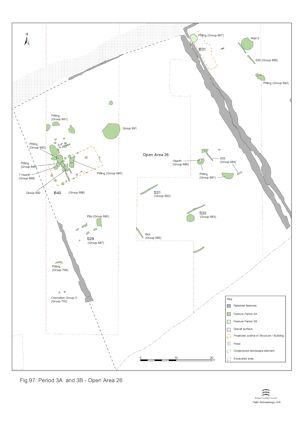
Two slots on the eastern side of Open Area 26 (25168, 25169 Group 684) perhaps represent further subdivision of the enclosure (Figure 97). They are conjectured to define the corner of a fence-line, the northern and eastern extents of which were not traced.
25168 (seg. 23079) is traced for c. 3.9m and runs on a SE-NW alignment. Up to 0.35m wide and 0.2m deep it is filled with two deposits. 25169 (seg. 23066) is 2.5m long, 0.3m wide and 0.2m deep. Aligned SW-NE, it has traces of burning at its north-east end.
They may be directly contemporary with the other elements of the new fence system (Structures 29, 31, 32 and other fence Group 685) imposed within this enclosure in Period 3 or may post-date them slightly - as Structure 33 post-dates some of the pits of Group 681.

Alternatively, S30 (OA26) and S33 (OA25) could conceivably be parts of the same sub-enclosure to the rear of, and associated with, Period 2B-3 Building 31. If so, this would infer a westward shift in the boundary between the two enclosures - i.e. now running between Structures 31/32 and 33. However, there is no tangible direct evidence for such a boundary movement.
Internet Archaeology is an open access journal based in the Department of Archaeology, University of York. Except where otherwise noted, content from this work may be used under the terms of the Creative Commons Attribution 3.0 (CC BY) Unported licence, which permits unrestricted use, distribution, and reproduction in any medium, provided that attribution to the author(s), the title of the work, the Internet Archaeology journal and the relevant URL/DOI are given.
Terms and Conditions | Legal Statements | Privacy Policy | Cookies Policy | Citing Internet Archaeology
Internet Archaeology content is preserved for the long term with the Archaeology Data Service. Help sustain and support open access publication by donating to our Open Access Archaeology Fund.